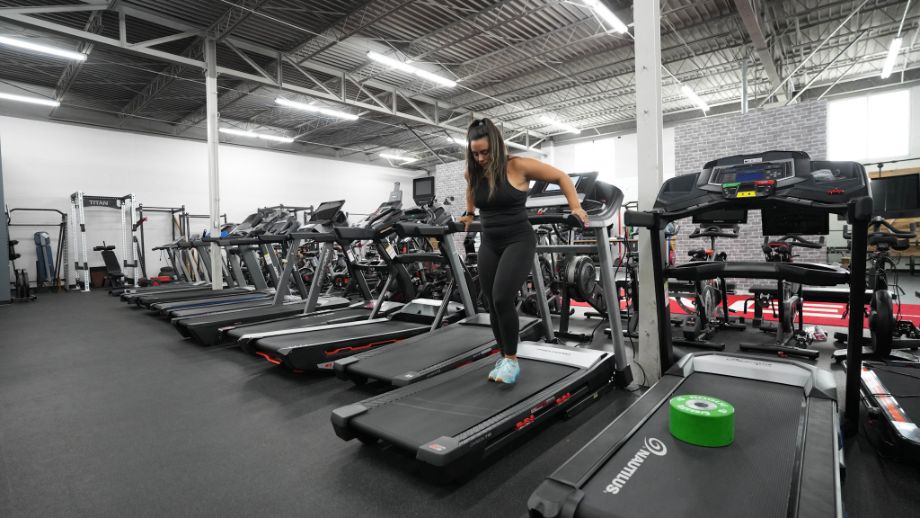We test and review fitness products based on an independent, multi-point methodology. If you use our links to purchase something, we may earn a commission. Read our disclosures.
Walking and jogging backwards on the treadmill is a safe, highly beneficial exercise that benefits your joints, increases muscle strength, and improves body coordination. Plus, you can start with just a few minutes a day.
Walking has long been established as an exercise that’s good for everyone to partake in. It can help you build stamina, burn calories, and improve heart health. Most experts recommend a daily 10 to 30 minute walk for maximum benefit, and many of us take that to heart—so much so that we wear watches that track how many steps we take each day!
RELATED: Walking Technique
But what about walking backwards? Is it an activity we should regularly add to our fitness routines, or is it more of a fad exercise trend?
You may be surprised, but research suggests that walking and jogging backwards on the treadmill can be incredibly beneficial both physically and mentally. So if you’ve ever been curious about this activity or seen people moving backward on a treadmill at the gym and wondered why, I encourage you to read on. We’ll talk about the benefits and risks of reverse walking and how to get started safely.
RELATED: Best Treadmill for Walking
Benefits of Walking and Jogging Backwards on the Treadmill
We already know that the benefits of walking and jogging are significant. These activities improve cardiovascular health, increase muscular endurance, change body composition, and help the body fight or prevent certain diseases like high blood pressure and type 2 diabetes. It’s not a great leap to extrapolate these benefits for walking and jogging backwards as well.
But, as with any physical activity, the benefits are only gained when you learn how to do it correctly. Too often, we see people holding onto handrails when they try walking or jogging backwards on the treadmill. The unfortunate result of that is horrible posture and being hunched over. This can cause more problems than it solves!
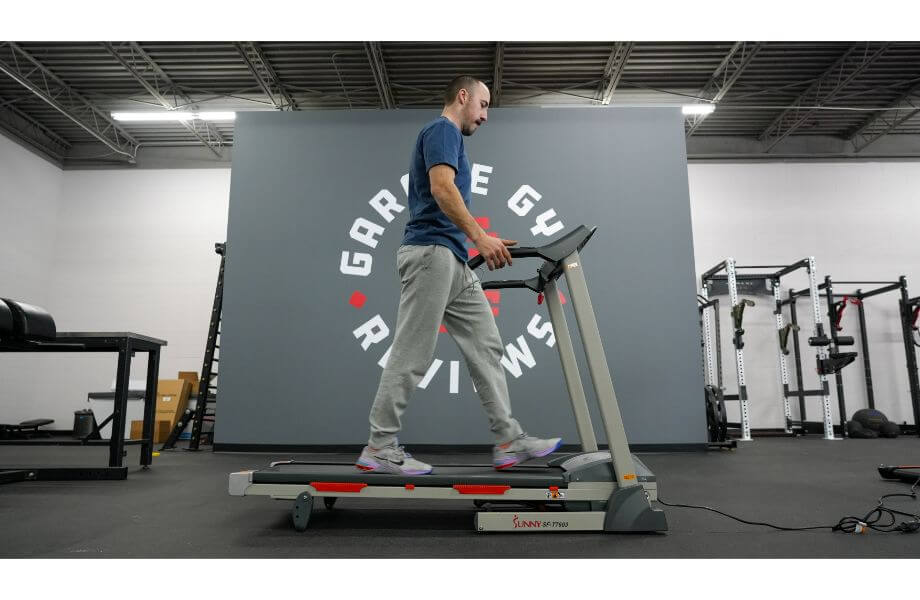
So, if you’re going to reap the benefits of this activity, be brave, and learn how to do it correctly. Start off slowly and practice transitioning between forward and backward walking several times. Before you know it, you’ll be a pro!
Here are five benefits of walking and jogging backwards on the treadmill.
1. Improves Your Coordination and Mental Function
Backwards treadmill walking or jogging can quickly improve coordination, body awareness, and mental focus. We often think of the physical effects of exercise, but when we move our bodies in new ways, it also sharpens our minds. You don’t need to think much to walk normally, but your brain is activated when you turn around and move in the opposite direction.
RELATED: Jogging vs Running
Just as your mental focus must increase when walking or running backwards, your body awareness must rise as well. A study published in the Journal of Physical Therapy Science1 assessed a small group of 33 people to examine the real benefits that backward walking had on their balance and gait. They found that reverse walking on the treadmill positively affected both, and their natural coordination increased as a result.
This makes total sense when you think about it. Since you can’t see where you’re going when you walk backwards, you must rely more on spatial cues and body awareness than when walking regularly.
2. Reduces Knee Pain
Knee pain is a common ailment in the running community. Sports medicine practitioners and physical therapists often recommend non-impact cross-training activities like the elliptical, rowing workouts, or cycling as alternatives to running. Reverse walking has recently been an addition to this list of recommended activities.
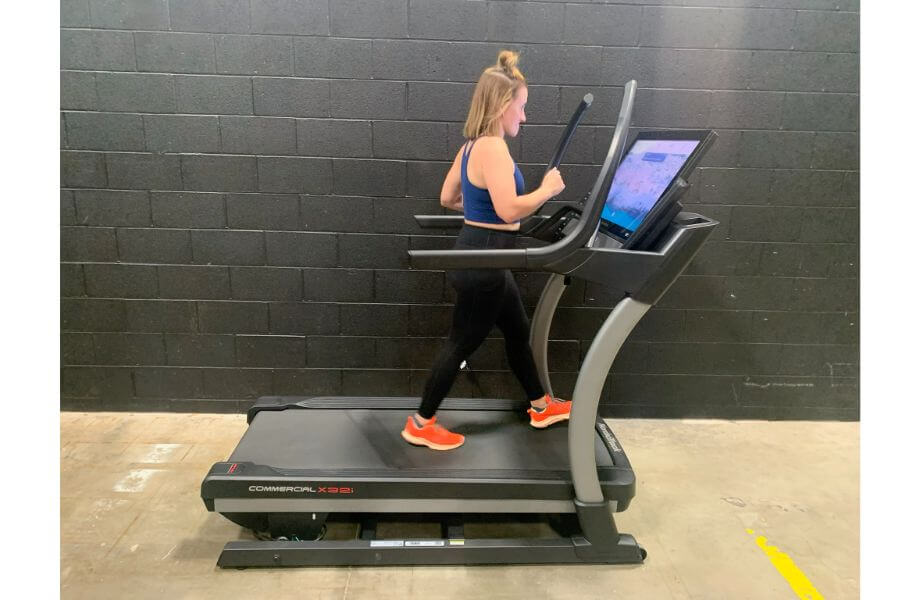
In 2019, a study published in the Journal for BMC Musculoskeletal Disorders2 looked at a cohort over six weeks to understand the effect walking backwards had on people suffering from knee osteoarthritis. The results were compelling. Researchers found that pain intensity had decreased and leg muscle strength had increased compared to the control group.
It makes sense… When you walk normally, body weight is transferred from the heel to the ball of your foot with each step. Backwards walking does the reverse, which takes some of the pressure off the knee joint. So, if you suffer from knee pain due to disease or a knee injury (like an ACL tear), consider adding this activity to build supporting muscle and reduce knee strain.
RELATED: Is Walking Backwards Good For You?
3. May Reduce Back Pain
Back pain is one of the leading causes of chronic pain in this country; nearly 65 million Americans report a recent episode of back pain3. There are many reasons why people suffer from it. Still, many people with chronic pain share a common trait: weak or atrophied muscles.
A study published in the Journal of Chiropractic Medicine4 discovered that strengthening the muscle groups in the lower back can help alleviate back pain. They found that backward walking leads to greater activation of the paraspinal muscles. These muscles are essential in regulating movement and assisting with counterbalancing.
The bottom line is that strengthening your back muscles can help relieve back pain over time. With that said, consult your doctor or physical therapist before undertaking a new routine to target back pain.
4. Works Different Muscles
When you’re on a treadmill, it can seem like you’re going nowhere fast. While that may be true in a location sense, your body is going through a cardiovascular and muscular journey. And once you flip around to start walking or jogging backwards on the treadmill, you begin to target a new set of muscles.
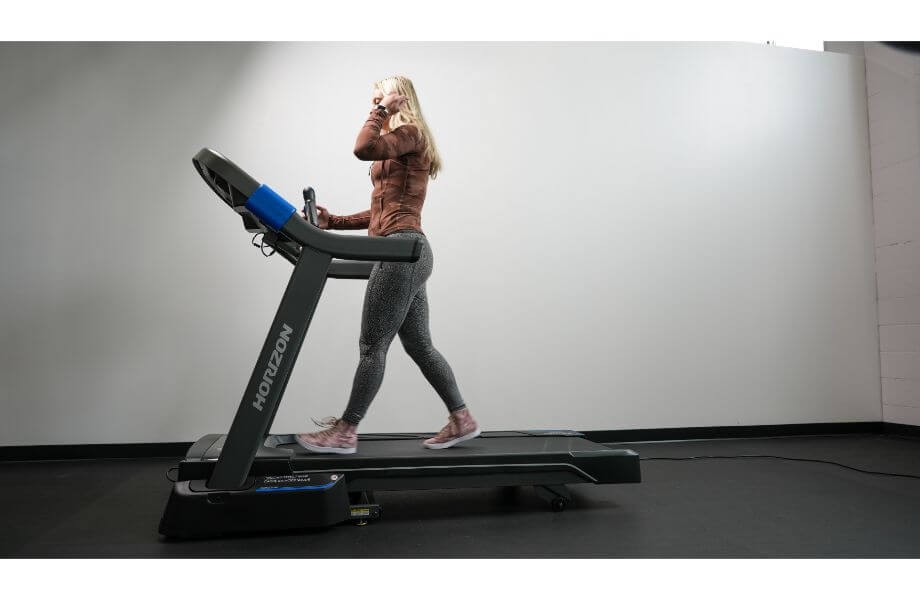
Backward movement targets your calves, hamstrings, lower back, and buttocks more so than regular walking. These large muscle groups don’t often get as much attention, so it’s a great way to balance your training. But backward walking also uniquely targets your quadriceps by contracting them isometrically and concentrically5. Physical Therapists have found that this kind of muscle activation is a more effective way of improving knee strength.
Additionally, once you let go of the handrails, you’ll notice yourself standing up really straight. Your abs must do a lot of work to keep you upright and not hunched over with a backward gait.
5. Improves Your Cardiorespiratory Fitness
Improving the body’s ability to use oxygen efficiently is the goal of every athlete. VO2 max—a measure of aerobic capacity—can improve by consistently walking or jogging backward on the treadmill. Why does this happen?
Try walking backwards for five minutes after walking normally for five minutes. You’ll immediately notice that your heart rate increases, your breath gets heavier, and your muscles burn. In other words, you’ll feel a noticeable increase in effort even if you don’t increase your pace. Do this activity consistently over time, and you’ll improve your cardiovascular health quite a bit.
In fact, a study in the International Journal of Sports Medicine6 found that walking or running backwards improves cardiorespiratory fitness for both forward and backward exercise. Their training group of young women saw a 32% decrease in O2 consumption during reverse activity and a 30% decrease during regular forward-facing exercise. Pretty compelling stuff!
Cons of Walking and Jogging Backwards on the Treadmill
The biggest con of walking or jogging backwards on the treadmill is the risk of injury. The good thing is that it’s a lot safer than trying to walk or run backwards outdoors. You deal with changing elevation, trip hazards, and other people when you’re outdoors. Not being able to see where you’re going outside is a whole other ballgame.
But even though the treadmill is a safer option, you still have to deal with the risk of tripping or falling off your machine. This can be especially risky if you try to do too much too soon and can’t keep up with the pace.
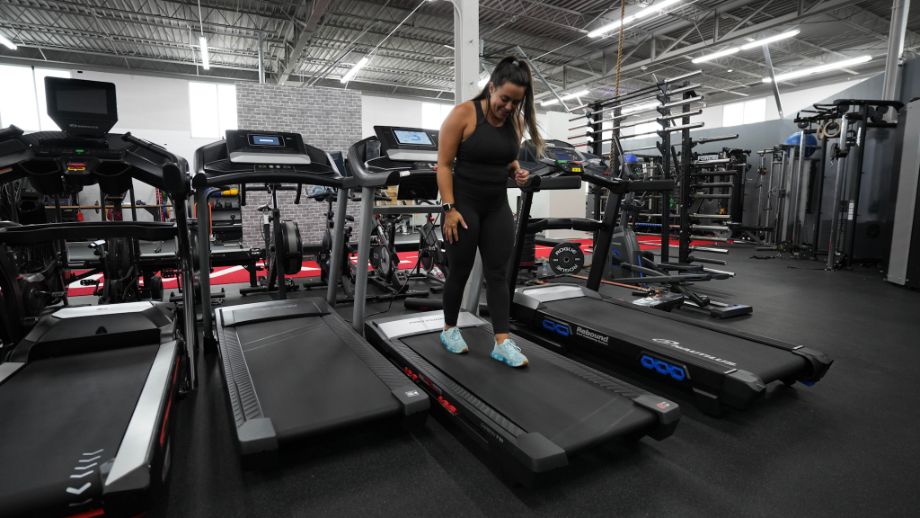
To mitigate the risk of injury, start off slowly. Walk backwards at a 1 or 2 MPH setting, and don’t ramp up the speed until you feel really comfortable. And try not to hold on to the handrails. Doing so will actually make you more unsteady than you would be standing straight up.
If you feel like you’re about to lose your balance, immediately grab the side rails and jump off the belt. Calm yourself, slow down the pace, and try again.
How to Walk or Jog Backwards on the Treadmill
Like any new activity, learning to walk or jog backward on the treadmill takes a little practice. Suppose you’ve never tried to transition from forward to backward walking before. In that case, you may not know how awkward it can feel initially.
RELATED: Balance Exercises
Instead of jumping your body around, smoothly pivot on your foot and quickly rebalance yourself. In the beginning, most people are cautious and hold on to the side rails for balance. It’s okay if you do that at first, but don’t make it a habit. And definitely let go once you’re steady on your feet again.
Here’s how to safely progress from walking to jogging to running backwards.
Progress Safely: Start With Walking Backwards
If you’ve never done this before, you may be surprised at how difficult it is to walk backwards for any length of time. My first experience with this was with a personal trainer on iFIT who built a series of walking workouts around this concept. I loved her progression and thought it was a great way to learn how to do this safely.
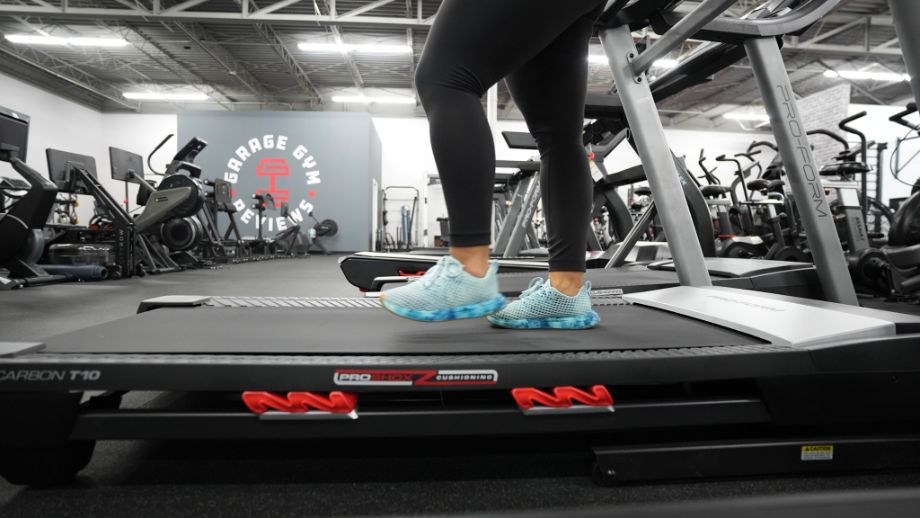
- Start off by walking forward at a very slow speed. We recommend starting at just 1 MPH.
- Pivot around on one foot, and then instead of taking a step forward, take a step backward. Continue walking backwards, hitting the ball of your foot first and then your heel.
- Walk backward for 60 to 90 seconds and then pivot around, so you’re walking forward again.
- Repeat this process for 15 to 20 minutes or until you feel comfortable with the transition.
Once you feel confident walking backwards at 1 MPH, start slowly increasing the speed. Do not go above 3 MPH at this stage. Gradually increase the time you’re walking backwards from 60 seconds to 20 minutes.
Then Try Jogging
Once your body, mind, and cardio system can handle walking backwards for 20 minutes, it’s time to try jogging. At this point, your quads, hamstrings, buttocks, and calves have all gotten stronger, and the backward locomotion should feel more comfortable.
To start a backward jogging session:
- Start off with a reverse walking warmup for 5 to 10 minutes.
- After the warmup is complete, turn around so you’re forward-facing and increase the speed to 4-5 MPH. Pivot again and start the backward jog.
- You may want to practice transitioning between a forward and backward jog for your first few sessions. This will help your body acclimate to the movement more quickly.
Remember, jogging backward will feel much more demanding than you expect, and this is the first time you’ve picked up the pace. Start off with just a few minutes of backward jogging at a time. When you’re ready, increase the time and speed as you see fit.
Finally, Try Running Backwards
The next step is to start running backwards on the treadmill. Follow the same sequence as before and run at an easy pace until the movement feels natural. By this stage, you should notice an increased calorie burn as your body works hard to maintain position, increased quad strength, and stabilization of your knee, hip, and ankle joints.
And after all your hard work, if you want to impress your friends with your mind-body coordination, post a video of you running backwards on social media!
RELATED: Best Running Shoes for Beginners
How to Stay Safe While Walking or Jogging Backwards
Safety is always the number one concern when trying a new activity. The good news is that walking or jogging backwards on a treadmill is far safer than doing so outdoors. There’s no risk of stepping into a hole or tangling up in a dog leash. With that said, you still risk tripping or falling on a treadmill, especially if you’re brand new to the activity.
RELATED: A Comprehensive Guide to Treadmill Safety
Take advantage of the handrails, the sides of the treadmill belt, and the emergency stop. Treadmills have a lot of built-in safety, so you don’t end up flying off the back end like in a comedic skit.
Who Should Try It?
Anyone who wants to shake up their exercise routine should try walking or jogging backwards on the treadmill. It’s an excellent way to increase your VO2 max and engage your muscles in a way that’s hard to do in other settings. And if you’re prone to injury—especially in your knees or lower back—this may help alleviate some of the strain and strengthen supporting muscles.
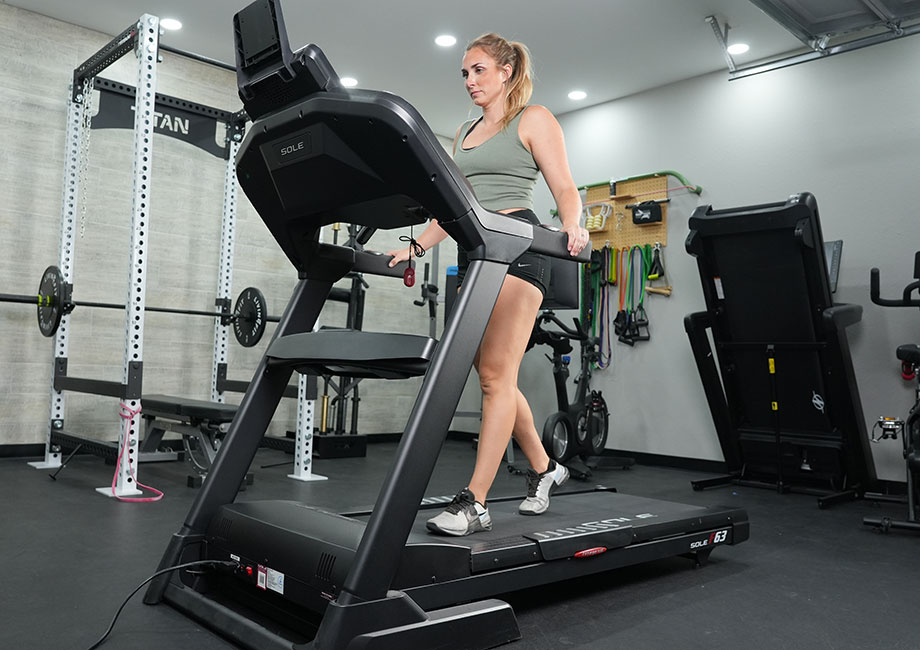
In short, anyone and everyone should try it! You can add a few minutes of backward walking or jogging once or twice in an extended treadmill set or work up to 20 to 30 minutes of backward running over time. And don’t be afraid to add some elevation. Adding an incline to the treadmill will give you the hill effect and target those muscles more effectively!
RELATED: Incline Treadmill Benefits
Walking and Jogging Backwards on the Treadmill: Final Thoughts
Walking or jogging backwards on the treadmill is an excellent workout for beginners and experts. It not only improves body coordination and mental focus but can also help reduce knee and lower back pain, increase muscle strength, and improve your VO2 max. Start with a slow walk, move to a light jog, and soon enough, you’ll find yourself running backward! Just be sure to take basic safety precautions to prevent injuries.
Walking and Jogging Backwards on the Treadmill: FAQs
How Long Should I Walk Backward?
Reverse walking for 10 to 15 minutes three or four days per week is a great place to start. This will hit all the benefits we discussed without adding too much to your exercise routine. You’ll likely see quite a few changes in a short time, including muscle strength, decreased heart rate, and increased O2 efficiency.
Will Walking Backwards Help Me Lose Weight?
Walking backwards is known to burn nearly 40% more calories per minute than regular walking. So, yes, if you incorporate a consistent reverse walking routine into your fitness plan, you will likely start to change your body composition. But remember, losing weight isn’t always the goal or the result of exercise. The number on the scale may be higher even though you have less body fat and increased muscle mass.
Is Walking Backwards Good for your Hips?
It is! Physical therapists often use walking backwards to improve the gait and mobility of patients. With consistent practice, you’ll likely experience an increased range of motion in your knees, ankles, and hips. At the same time, you’ll gain strength in the muscles that support these joints, making them more stable.
References
- Cha HG, Kim TH, Kim MK. Therapeutic efficacy of walking backward and forward on a slope in normal adults. J Phys Ther Sci. 2016;28(6):1901-1903. doi:10.1589/jpts.28.1901
- Anwar, Dilshad. Effect of 6-week retro or forward walking program on pain, functional disability, quadriceps muscle strength, and performance in individuals with knee osteoarthritis: a randomized controlled trial (retro-walking trial) – BMC Musculoskeletal Disorders. BMC Musculoskeletal Disorders, 9 April 2019.
- Chronic Back Pain | Health Policy Institute | Georgetown University. Health Policy Institute.
- Hussain, Mohammad Ejaz. Lumbar Muscle Activation Pattern During Forward and Backward Walking in Participants With and Without Chronic Low Back Pain: An Electromyographic Study. NCBI, 20 January 2019.
- Flynn TW, Soutas-Little RW. Mechanical power and muscle action during forward and backward running. J Orthop Sports Phys Ther. 1993;17(2):108-112. doi:10.2519/jospt.1993.17.2.108
- E. Terblanche, C. Page, J. Kroff, R. E. Venter. The Effect of Backward Locomotion Training on the Body Composition and Cardiorespiratory Fitness of Young Women. International Journal of Sports Medicine, 9 February 2004.
Further reading

Finding the best commercial treadmill on your own can be tough, which is why Garage Gym Reviews is here to save the day! Check out our five favorite options. Read more

How does an Olympic plate loadable weighted vest compare to traditional weighted vests? Find out in our Kensui EZ-Vest Weighted Vest review. Read more

Our KOS Kiss Your Blues Away review analyzes the nutrient facts of this popular superfood supplement. Is it any good? Find out here. Read more

A CPT describes how to do the kettlebell bench press with the correct form, common mistakes to avoid, and the benefits of performing this resistance exercise. Read more

